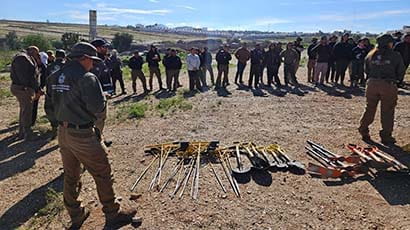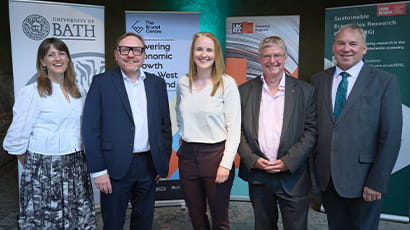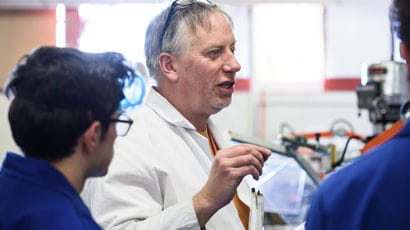Glow in the dark gemstones show the jewellery industry that laboratory-grown crystals can shine bright

A UWE Bristol researcher hopes to revolutionise the jewellery industry and its supply chains with the creation of unique gemstone and jewellery designs with ground-breaking properties - including the world’s first single stone glow-in-the-dark manmade crystal.
For the last three years, award-winning jewellery designer Sofie Boons, who’s a Crafts Council Research Fellow at the university’s Centre for Print Research (CFPR), has been undertaking tests on the viability, limitations and use of innovative and experimentally grown crystals in the production of contemporary jewellery.
Working in collaboration with Swiss company BREVALOR Sarl and using their new material ‘BRG’, Sofie has successfully facetted a single stone out of the material – offering jewellery designers a crystal which is not only brilliant when seen in daylight, but illuminates when seen in the dark.
This is a step-change in the development of gemstone materials for the jewellery industry. Such crystals and several new compositions emitting persistent luminescence light with various colours have properties very close to classical gemstones: their hardness allows them to be shaped and facetted, and their physical properties give them the optical appearance of gems.
The BRG crystals are grown using techniques very similar to those used for the growth of silicon single crystals. Silicon forms the backbone of modern technology starting with the transistor invented in the 1950’s and transitioning to the modern computer, telecommunications, and information technologies. Anyone carrying a mobile device is relying on the single crystals within. Today, the modern world functions because of single crystals. This ongoing progress is often referred to as the ‘crystal age’ and phosphorescent (i.e., the scientific term for ‘glow-in-the-dark’) single transparent crystals are a new addition to these developments.
Sofie said: “Today crystal growth is driving innovations in a range of sectors. However, in the jewellery industry lab-grown gemstones have sparked a war of words and much debate about their value. This despite their sustainability and creative potential. BRG demonstrates how crystal growth technologies could create materials that totally re-imagine what the gemstones available to us could do. This is the most exciting opportunity for contemporary jewellery designers, looking to create unique jewellery pieces.
“But, for this to happen there needs to be a change in attitude within the sector towards these laboratory-grown materials which are often referred to as synthetic. They need to be valued fairly in the industry, and scientists who are creating them shouldn’t be feared more than the most accomplished of thieves by gemstone dealers and retailers.”
The research into BRG began after Sofie contacted the founder and crystal grower at BREVALOR Dr. Daniel Rytz and through her work on her PhD she continues to challenge him to find solutions to problems when realising her ideas. He said: “I have been passionate about the creation of a transparent single crystal that would have phosphorescent effects for many years, and I am very pleased to have collaborated with Sofie on the translation of these materials into gemstones and wearable jewellery designs.”
The favourable properties of BRG gemstones are expected to trigger numerous new and spectacular ideas in the areas of contemporary jewellery, design and ornamental objects, according to Sofie. Her first contemporary jewellery pieces using BRG are a pair of earrings and pendant demonstrating the material’s unique ability to guide light when engraved. She is also working with Dr. Rytz on the launch of a range of gemstones that could be purchased by jewellers to enable them to incorporate the material in their designs.
Alongside her PhD, which is scheduled to be published in 2024, Sofie is planning several exhibitions in the Bristol and London areas, and in Germany, including in the gemstone city of Idar Oberstein. The exhibitions will mark the launch of a larger jewellery collection using more materials created by Dr. Rytz, as well as contemporary pieces of jewellery that challenge and question the norms surrounding these lab-grown gemstone materials.
Related news

12 December 2025
UWE Bristol’s environmentally conscious and student-focused accommodation wins three awards
Purdown View, the world's largest certified Passivhaus student accommodation development, has been recognised at Property Week Student Accommodation Awards.

25 November 2025
Health-tech start up MyCelsius launches breakthrough cooling tech for hot flushes developed at UWE Bristol’s Launch Space
A pioneering Bristol-based health-tech company developing cutting-edge cooling technology for hot flushes has credited UWE Bristol’s Launch Space incubator with playing a key role in accelerating its product development.

14 November 2025
Lecturer wins prestigious Times Higher Education award for innovation in teaching
A senior paramedic science lecturer at UWE Bristol has been named the most innovative teacher of the year in the Times Higher Education Awards 2025.

13 November 2025
Alliance Medical and UWE Bristol launch UK’s first PET-CT postgraduate certificate
In a move set to transform imaging education, Alliance Medical (AML) and UWE Bristol have joined forces to co-design and develop the UK’s first PET-CT Postgraduate Certificate (PG Cert).

13 November 2025
New AI research to revolutionise animal welfare
A UWE Bristol research project will combine behavioural science and AI to create technology that understands not only what animals do, but how they feel.

29 October 2025
UWE Bristol academic unveils breakthrough in energy-efficient AI at NATO science forum
Dr Jonathan Lancelot has developed a new form of AI that could transform how intelligent machines operate in space, defence, and remote environments.

07 October 2025
Academic playing role in project to find hidden graves in Mexico using drone technology
A UWE Bristol lecturer is playing a part in a project using drone technology to locate concealed graves in Mexico.

01 October 2025
New funding for researchers to develop trustworthy clinical AI for assessing brain activity
Researchers have received funding from UK Research and Innovation to help bring their innovative brain-monitoring AI technology closer to real-world use.

11 September 2025
New study to investigate augmented reality as an intervention for emotionally based school avoidance
A UWE Bristol researcher will support a new study exploring whether an augmented reality board game can help young people with emotionally based school avoidance (EBSA).

22 August 2025
A decade of Future Space: How UWE Bristol’s enterprise zone is powering innovation and economic growth
Tracey John, Director of Research and External Engagement, reflects on the impact of Future Space and its role as a launchpad for cutting-edge companies shaping the future of how we live and work.

11 July 2025
Wound dressings developed with support from UWE Bristol to be launched by global firm
Technology that a team of UWE Bristol scientists helped develop to aid the healing of chronic wounds will be used in new ‘smart dressings’ being launched by global medical company.

03 July 2025
Research lab The Brunel Centre opens to power sustainable and inclusive growth for the West of England
A new data and research centre designed to support sustainable and inclusive growth and industrial strategy in the region, has officially launched.
You may also be interested in

Media enquiries
Enquiries related to news releases and press and contacts for the media team.

Find an expert
Media contacts are invited to check out the vast range of subjects where UWE Bristol can offer up expert commentary.






